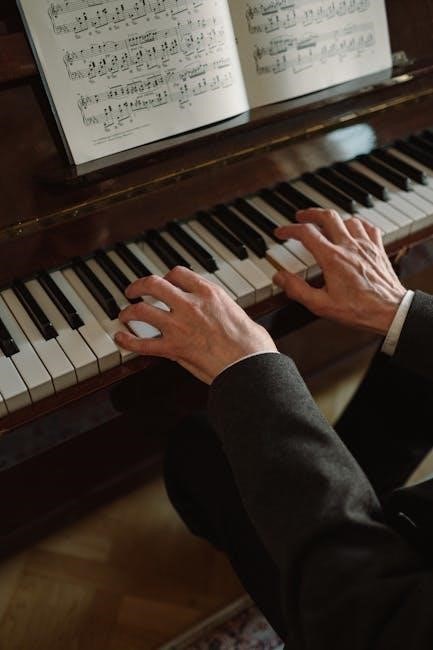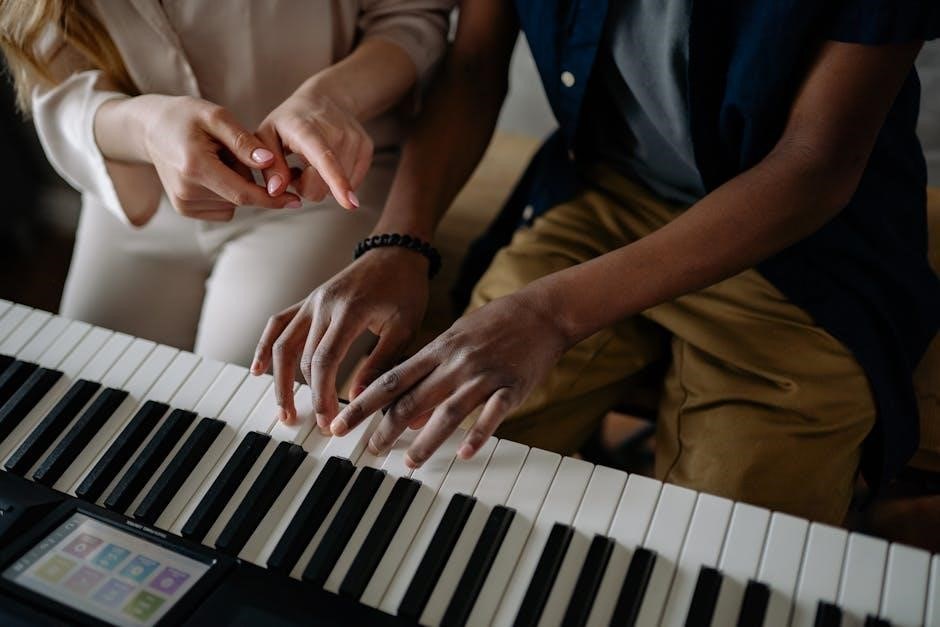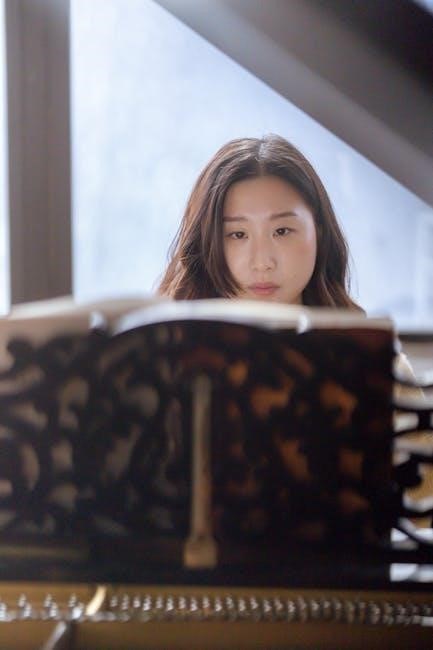August Wilson’s Pulitzer-winning The Piano Lesson (1987) is a poignant exploration of legacy, set in 1936 Pittsburgh. The play centers on a family heirloom—the piano, carved with ancestral images—symbolizing cultural identity and historical trauma, exploring themes of heritage and self-determination.
Overview of the Play
The Piano Lesson, set in 1936 Pittsburgh, revolves around the Charles family and their ancestral piano, carved with images of their enslaved ancestors; The play explores tensions between siblings Boy Willie and Berniece over the piano’s fate, symbolizing a clash between monetizing heritage and preserving family history. Against the backdrop of the Great Migration and the Depression, Wilson examines themes of legacy, identity, and cultural heritage, weaving a story that reflects the broader African-American struggle to reconcile past and present.
August Wilson and the Pittsburgh Cycle
August Wilson’s The Piano Lesson is part of his renowned Pittsburgh Cycle, a series of ten plays chronicling the African-American experience across the 20th century. Each play is set in a different decade, from the 1900s to the 1990s, offering a mosaic of Black life in America. Wilson’s cycle reflects his vision of capturing the cultural, social, and historical journey of African Americans, with The Piano Lesson representing the 1930s. The cycle is celebrated for its profound exploration of identity, legacy, and resilience, solidifying Wilson’s place as a leading voice in American theater.
Setting and Historical Context
The Piano Lesson is set in Pittsburgh in 1936, during the Great Depression, a time of economic hardship and racial inequality. The play reflects the historical context of Black migration from the rural South to the urban North, seeking better opportunities. Wilson vividly portrays the struggles faced by African Americans, including structural injustice and limited access to resources. The piano, a family heirloom, symbolizes the legacy of slavery and resilience. This setting underscores the tension between preserving the past and striving for a better future, central to the play’s exploration of identity and heritage.

Major Themes in “The Piano Lesson”
Wilson explores themes of legacy, family heritage, memory, racism, spirituality, grief, hope, and history, weaving them into a powerful narrative about identity and resilience.
Legacy and Family Heritage
In The Piano Lesson, legacy and family heritage are central themes, embodied by the piano, a relic of the Charles family’s history under slavery. The piano, carved with ancestral images, serves as a tangible connection to their past, raising questions about its preservation or sale. This debate between Boy Willie and Berniece reflects broader struggles with legacy—whether to honor history or seek liberation through its release. The piano becomes a symbol of both cultural identity and the weight of inherited trauma, underscoring the complexity of African-American heritage.
Memory and Historical Legacy
In The Piano Lesson, memory and historical legacy are intertwined through the piano, a symbol of the Charles family’s past. Carved with images of enslaved ancestors, it serves as a tangible record of their history under slavery. The play explores how memories of oppression and resilience shape identity, with characters grappling with whether to preserve or relinquish these legacies. Set against the backdrop of the Great Migration and the Depression, the piano embodies the collective memory of African Americans, highlighting the tension between honoring history and seeking liberation from its burdens.
Racism and Self-Determination
In The Piano Lesson, August Wilson examines the impact of racism and the quest for self-determination among African Americans in the 1930s. The play highlights systemic oppression and economic inequality, as characters like Boy Willie and Lymon embody contrasting approaches to achieving freedom. Boy Willie’s desire to sell the piano for land represents a pragmatic pursuit of financial independence, while Berniece’s refusal reflects a commitment to preserving cultural heritage. Their conflict underscores the struggle to reconcile past injustices with future aspirations, illuminating the complex legacy of racism and the fight for autonomy in African-American life.
Spirituality and the Supernatural
August Wilson interweaves spirituality and the supernatural in The Piano Lesson, creating a rich tapestry of African and Christian influences. The ghost of Robert Sutter haunts the family, symbolizing unresolved historical trauma. The piano itself becomes a spiritual artifact, its carvings telling ancestral stories and holding the family’s collective memory. Berniece’s refusal to play the piano reflects her internal conflict with the past, while Boy Willie’s actions challenge these spirits. Through these elements, Wilson explores the power of spirituality to both burden and liberate, highlighting the enduring connection to African heritage and the struggle for emotional healing.
Grief, Hope, and History
In The Piano Lesson, August Wilson explores the interplay between grief, hope, and history through the Charles family’s struggles. The piano serves as a tangible link to their ancestors, embodying both the pain of slavery and the resilience of their heritage. Berniece’s reluctance to play the piano reflects her grief over the past, while Boy Willie’s determination to sell it symbolizes hope for a better future. Wilson weaves these emotions into the broader narrative of African-American history, illustrating how the past shapes the present while offering a pathway to healing and liberation.

Symbols in “The Piano Lesson”
The piano and its carvings are central symbols, representing the Charles family’s history, cultural identity, and the weight of their ancestors’ experiences under slavery and oppression.
The Piano as a Symbol of Family History
The piano in August Wilson’s The Piano Lesson serves as a powerful symbol of the Charles family’s history and legacy. Carved with images of their enslaved ancestors, it embodies the family’s collective memory and the traumatic experiences of slavery. The piano is not just a musical instrument but a tangible connection to their past, holding stories and emotions that define their identity.
Through the piano, Wilson explores themes of heritage and the weight of history, highlighting the struggle to preserve or let go of the past. It becomes a focal point of conflict and reflection for the characters, symbolizing both their roots and their future.
Carvings on the Piano
The intricate carvings on the piano in The Piano Lesson are deeply symbolic, representing the Charles family’s ancestral history. Crafted by their enslaved ancestors, these carvings depict African imagery and stories, serving as a visual archive of their heritage. The carvings embody the pain of slavery and the resilience of their forebears, making the piano a living artifact of their history. They also reflect the family’s connection to their African roots, emphasizing cultural identity and the enduring legacy of their ancestors.
The Piano as a Representation of Cultural Identity
The piano in The Piano Lesson symbolizes the blending of African and American cultural identities. It represents the Charles family’s heritage, with carvings that reflect their African roots and the historical trauma of slavery. The piano embodies the tension between preserving cultural legacy and embracing a new identity in America. Through its presence, Wilson highlights the struggle to reconcile African traditions with the realities of life in a racially divided society. The piano becomes a powerful symbol of resilience, cultural pride, and the enduring quest for identity among African Americans.

Character Analysis
The characters in The Piano Lesson embody complex themes through their struggles. Boy Willie seeks freedom, Berniece protects heritage, Doaker narrates history, and Lymon embodies self-determination.
Boy Willie: The Struggle for Freedom and Identity
Boy Willie embodies the struggle for freedom and identity, reflecting Wilson’s exploration of self-determination. He seeks to reclaim his family’s legacy by selling the piano, symbolizing economic independence. His journey mirrors the broader African-American quest for liberation and cultural identity. Through his character, Wilson highlights the tension between preserving heritage and forging a new future, illustrating the complexities of racial identity and financial autonomy in 1930s America.
Berniece: Preserving Family History
Berniece represents the preservation of family history, steadfastly protecting the piano as a symbol of her ancestors’ legacy. Her refusal to sell it reflects her commitment to honoring the past, despite the emotional burden it carries. Through her character, Wilson explores the importance of cultural heritage and the weight of historical memory. Berniece’s stance underscores the tension between letting go and holding on, highlighting the enduring impact of slavery and racism on African-American identity and family narratives.
Doaker: The Keeper of Family Stories
Doaker serves as the family’s storyteller, preserving the history of the Charles family through his vivid narratives. His speeches, particularly about the piano’s origins, highlight its significance as a cultural artifact; Doaker’s wisdom and understanding of the family’s past provide context to the present tensions, making him a bridge between generations. His role underscores the importance of oral tradition in maintaining African-American cultural identity and the interconnectedness of personal and historical memory. Doaker’s insights offer depth to the play’s exploration of legacy and identity.
Lymon: Different Attitudes Toward Self-Determination
Lymon represents a contrasting perspective on self-determination, offering a more cautious and pragmatic approach compared to Boy Willie. His character reflects the tension between ambition and realism, emphasizing the challenges faced by African Americans in the 1930s. Lymon’s cautious nature and desire for stability contrast with Boy Willie’s boldness, illustrating the diverse ways individuals navigate systemic oppression. Through Lymon, Wilson explores the complexities of striving for autonomy amidst societal constraints, highlighting the internal and external barriers to self-determination.
Historical Context and Social Issues
Set in the 1930s, the play reflects the Great Migration, structural injustices of the Depression Era, and cultural shifts, highlighting the African-American struggle for equality and identity.
The Great Migration and Its Impact
The Great Migration serves as a pivotal backdrop in The Piano Lesson, illustrating the mass movement of African Americans from the rural South to urban North during the 20th century. This historical event shaped the Charles family’s journey, reflecting themes of displacement and resilience. August Wilson portrays how this migration influenced cultural shifts, economic struggles, and the quest for identity. The play captures the tension between preserving ancestral roots and embracing new opportunities, highlighting the profound impact of this era on African-American life and heritage.
Structural Injustice in the Depression Era
The Great Depression amplifies the systemic inequality faced by African Americans in The Piano Lesson. Economic hardship and limited opportunities reflect the broader racial disparities of the 1930s. Wilson portrays how structural injustice perpetuates cycles of poverty and limits upward mobility, particularly for Black families. The play highlights the struggle to achieve financial independence and dignity amid a society rigged against them, underscoring the long-term effects of racial and economic oppression on individuals and communities.
Black Migration and Cultural Shifts
The Great Migration serves as a backdrop for The Piano Lesson, illustrating how African Americans sought better lives in the North. This movement reshaped cultural identities, blending Southern roots with Northern realities. Wilson explores the tension between preserving ancestral traditions and adapting to new environments. The play reflects the emotional and social shifts faced by families like the Charles, navigating a changing world while holding onto their heritage. This migration symbolizes both hope and loss, shaping the characters’ struggles and aspirations in 1930s Pittsburgh.

Cultural Significance of the Play
The Piano Lesson bridges African and American identities, blending cultural heritage into a powerful narrative. It serves as a parable for the African-American experience, reflecting Wilson’s vision of identity and resilience, making it a cornerstone of American theater.
African and American Cultural Identity
In The Piano Lesson, August Wilson masterfully intertwines African and American cultural identities through the Charles family’s story. The piano, with its ancestral carvings, symbolizes the blending of African heritage and American experiences. Wilson highlights the tension between preserving African roots and adapting to a new cultural landscape. This duality reflects the broader African-American struggle to reconcile past and present, making the play a powerful exploration of identity. The narrative underscores the importance of cultural fusion in shaping individual and collective identity.
The Play as a Parable for African-American Experience
The Piano Lesson serves as a profound parable for the African-American experience, exploring themes of legacy, oppression, and resilience. The piano, with its carved history, mirrors the collective memory of African descendants in America. The conflict over its fate—whether to sell or preserve—symbolizes broader struggles: economic survival vs. cultural preservation. Wilson uses this family drama to reflect the nation’s racial history, offering a universal story of identity and the enduring impact of the past on the present.
August Wilson’s Vision for African-American Identity
August Wilson’s The Piano Lesson reflects his vision for African-American identity, emphasizing the importance of cultural heritage and the blending of African and American traditions. Wilson believed that understanding and embracing one’s history was essential for empowerment. The play highlights the struggle to reconcile the past with the present, advocating for a unified identity rooted in ancestral memories. Through the piano, Wilson symbolizes the need to honor history while forging a future, ensuring that African-Americans reclaim and celebrate their unique cultural legacy.
Dramatic Structure and Style
Wilson’s The Piano Lesson employs a non-linear narrative, rich symbolism, and poetic dialogue, blending the past and present to create a layered, emotionally resonant dramatic experience.
Wilson’s Use of Subtext
August Wilson masterfully employs subtext in The Piano Lesson to convey deeper meanings beneath the characters’ dialogue. Doaker’s narrative speeches, for instance, reveal the piano’s historical significance and the family’s ancestral legacy. The play’s non-linear storytelling and rich symbolism allow themes like memory, identity, and historical trauma to resonate subtly. Wilson’s characters often express unspoken emotions and conflicts, such as Berniece’s internal struggle with the piano’s cultural weight. This layered approach enhances the emotional depth and complexity of the narrative, making the play a powerful exploration of African-American identity and history.
Doaker’s Speeches and Their Significance
Doaker’s speeches in The Piano Lesson serve as a narrative bridge, linking the Charles family’s past to their present struggles. His storytelling reveals the piano’s origins and the ancestors whose images are carved into it, emphasizing the instrument’s cultural and historical value. Doaker’s words often frame the play’s central conflict, highlighting the tension between preserving legacy and seeking economic freedom. His narratives not only provide context but also underscore the emotional weight of the piano, making it a symbol of both heritage and division within the family. His role as a storyteller cements the play’s connection to its historical roots.
Rich Symbolism and Authentic Dialogue
August Wilson’s The Piano Lesson is renowned for its rich symbolism, particularly through the piano, which embodies the Charles family’s history and cultural identity. The intricate carvings on the piano symbolize the ancestors’ stories and the legacy of slavery. Wilson’s authentic dialogue captures the essence of African-American vernacular, adding depth and realism to the characters’ interactions. This blend of powerful symbols and genuine speech creates a vivid portrayal of the family’s struggles, making the play a compelling exploration of heritage, memory, and identity. The dialogue also reflects the characters’ emotional journeys, enriching the narrative with authenticity and resonance.

Adaptations and Performances
Recent adaptations of August Wilson’s play include a film featuring Samuel L. Jackson, John David Washington, and Ray Fisher. A new production by Joburg Theatre is scheduled for 2025, showcasing its enduring relevance. Part of Wilson’s Pittsburgh Cycle, the play continues to captivate audiences with its powerful narrative.
Notable Productions and Casts
Samuel L. Jackson first performed as Boy Willie in The Piano Lesson at Yale Repertory Theatre in 1987, marking a pivotal moment in the play’s history. Denzel Washington has championed adaptations, including a film version featuring John David Washington and Ray Fisher. The original Broadway production, directed by Lloyd Richards, earned widespread acclaim and a Pulitzer Prize. Recent productions, such as the 2025 Joburg Theatre staging, highlight the play’s enduring relevance. These adaptations underscore the cultural significance of Wilson’s work, drawing star-studded casts to bring the Charles family’s story to life.
Samuel L. Jackson’s Connection to the Play
Samuel L. Jackson holds a significant connection to The Piano Lesson, first portraying Boy Willie at Yale Repertory Theatre in 1987; This role marked his early association with August Wilson’s work. Jackson’s performance was pivotal, showcasing his ability to embody the complexities of Boy Willie’s character; His involvement in the play highlights the enduring impact of Wilson’s storytelling and the importance of the role in Jackson’s career, solidifying his link to the powerful narrative of the Charles family and their ancestral legacy.
Recent Adaptations and Their Reception
Recent adaptations of The Piano Lesson have garnered significant attention, with a notable film version featuring Samuel L. Jackson, John David Washington, and Ray Fisher. Directed by Denzel Washington, the adaptation stays true to Wilson’s original narrative while bringing fresh vitality to the story. Critics praise its faithful portrayal of the Charles family’s struggle and the preservation of the play’s emotional depth. The film has been well-received, highlighting the timeless relevance of Wilson’s exploration of legacy, identity, and cultural heritage, ensuring his vision continues to resonate with contemporary audiences.

Critical Reception and Impact
August Wilson’s The Piano Lesson earned widespread acclaim, winning the Pulitzer Prize and solidifying its place as a landmark in African-American literature, exploring themes of legacy and identity with profound depth.
Pulitzer Prize and Acclaim
August Wilson’s The Piano Lesson received the Pulitzer Prize for Drama in 1987, a testament to its profound exploration of African-American heritage. Critics praised its rich characters and themes, particularly its use of the piano as a symbol of family history. The play’s success underscored Wilson’s mastery in blending storytelling with cultural depth, cementing its status as a landmark in American theater. Its acclaim continues to resonate, making it a vital study in literary and dramatic circles.
Analysis of Themes and Motifs
August Wilson’s The Piano Lesson explores themes of legacy, memory, and cultural identity through the symbolic piano. The play delves into the tension between preserving family history and embracing progress, as seen in Berniece’s refusal to play the piano. Memory is a double-edged sword, offering connection to ancestors but also reopening wounds of slavery and racism. The piano’s carvings symbolize the family’s history and resilience, while its presence sparks debates about identity and self-determination. Wilson’s rich symbolism and nuanced dialogue illuminate the African-American experience, blending grief, hope, and the weight of history.
Study Guides and Educational Resources
Study guides for The Piano Lesson offer comprehensive analyses, including summaries, themes, and significant quotes. Resources like Course Hero and eNotes provide in-depth insights, aiding students in understanding Wilson’s exploration of legacy and identity. These guides highlight the play’s historical context, such as the Great Migration, and its cultural significance. They also explore characters like Boy Willie and Berniece, analyzing their roles in the struggle to reconcile past and present. These materials are invaluable for essays, tests, and deeper comprehension of Wilson’s vision for African-American identity and experience.
The Piano Lesson is a powerful exploration of legacy, identity, and cultural heritage, offering profound insights into the African-American experience through its rich symbolism and compelling narrative.
The Lasting Legacy of “The Piano Lesson”
The Piano Lesson remains a cornerstone of African-American literature, resonating with themes of legacy, identity, and cultural preservation. Its exploration of historical trauma and familial bonds continues to captivate audiences, solidifying August Wilson’s place as a literary giant. The play’s enduring relevance is evident in its adaptations, including a recent film version, ensuring its message reaches new generations. The piano, as a symbol of heritage, embodies the struggle and triumph of a people, making the play a timeless parable of identity and resilience.
Relevance in Modern Context
August Wilson’s The Piano Lesson retains profound relevance today, addressing universal themes of identity, justice, and cultural preservation. Its exploration of systemic racism and the struggle for self-determination resonates amid ongoing discussions of racial equity. The play’s focus on intergenerational trauma and the weight of history parallels modern conversations about reparations and healing. Recent adaptations, including a film version, introduce the play to new audiences, ensuring its legacy endures. Wilson’s work continues to bridge the past and present, offering insights into the African-American experience and its timeless quest for justice and dignity.
Further Reading and Resources
Explore study guides, interviews with August Wilson, and historical materials for deeper insights into The Piano Lesson and its cultural significance, available online.
Recommended Study Guides
For a deeper understanding of The Piano Lesson, explore comprehensive study guides available online. These resources include detailed summaries, character analyses, and thematic breakdowns. Platforms like Course Hero and eNotes offer insightful analyses of symbols, motifs, and historical context. Additionally, study guides provide critical essays, discussion questions, and quotes to aid in essay writing. These tools are invaluable for students and scholars seeking to unpack Wilson’s rich storytelling and the cultural significance of the play. They offer a structured approach to analyzing the text and its profound themes.
Interviews with August Wilson
Interviews with August Wilson offer profound insights into his creative vision and the cultural significance of The Piano Lesson. Wilson discusses the play’s exploration of legacy, identity, and racism, emphasizing the piano as a symbol of ancestral history. He reflects on the importance of preserving African-American cultural heritage and the role of art in addressing historical injustices. These interviews provide a deeper understanding of Wilson’s intentions and the broader themes of his work, making them invaluable for scholars and enthusiasts alike. They reveal his commitment to capturing the African-American experience with authenticity and depth.
Historical and Cultural Background Materials
Historical and cultural background materials for The Piano Lesson provide context on the Great Migration and the Great Depression, shaping the African-American experience in the early 20th century. The play reflects the structural injustices faced by Black Americans during this period, including economic struggles and racial discrimination. Cultural materials highlight the significance of the piano as a symbol of heritage, connecting the Charles family to their enslaved ancestors. These resources offer insights into August Wilson’s portrayal of African-American identity, blending history and culture to enrich understanding of the play’s themes and motifs.
